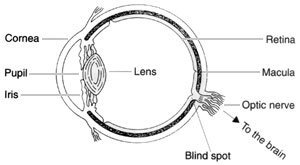  |
|
  |
|
| Eye Sight Examination How can diabetes affect the eye? Your eye has a lens and an aperture (opening ) at the front, which adjust to bring object into focus on the retina at the back of the eye. The retina is made up of a delicate tissue that is sensitive to light, rather like the film in a camera. At the center of the retina is the macula which is a small area about the size of a pinhead. This is the most highly specialised part of the retina and it is vital because it enables you to see fine detail and read small print. The other parts of the retina give you side vision (peripheral vision). Filling the cavity of the eye in front of the retina is a clear jelly-like substance called the vitreous humour. Diabetes can affect the eye in a number of ways. These usually involves the fine network of blood vessels in the retina - hence the term diabetic retinopathy. The importance of early treatment Although your vision may be good, changes can be taking place to your retina that need treatment. And because most sight loss in diabetes is preventable: - early diagnosis is vital |
The Types of Disease Found :
|
your family doctor, diabetologist or optometrist can examine for diabetic retinopathy. Photographs are sometimes used to detect abnormalities without any other form of test. If a problem is found you will be referred to a consultant ophthalmologist (a doctor speacialising in eyes) at a hospital eye clinic.
If new blood vessels are growing, more extensive laser treatment has to be carried out. In eight out of ten cases laser treatment causes the new blood vessels to disappear. |
